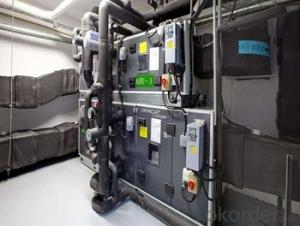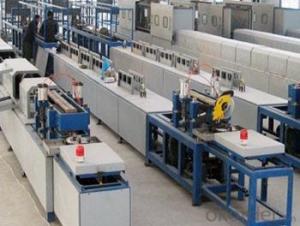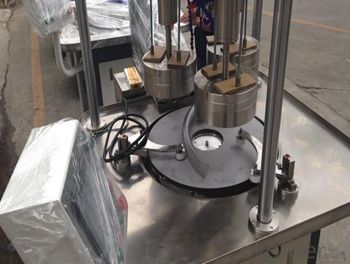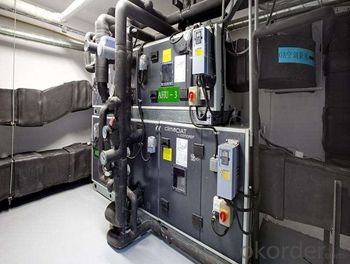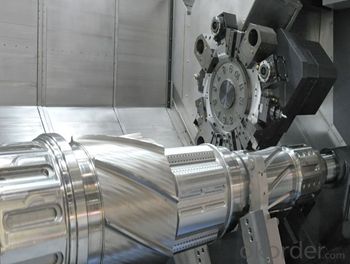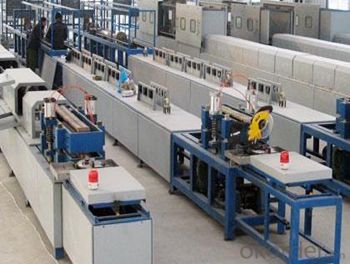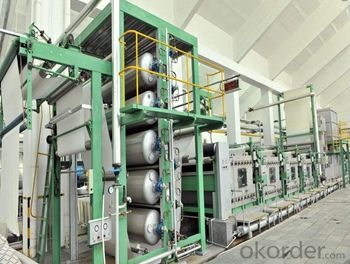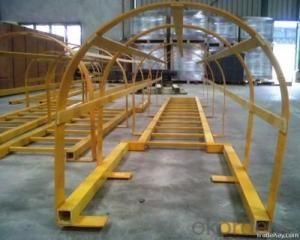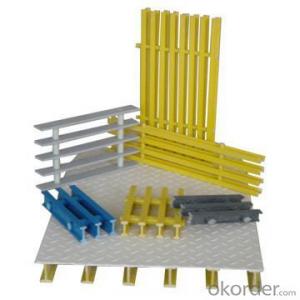FRP pultruded grating with Anti-ageing and best quality on hot sales
- Loading Port:
- Tianjin
- Payment Terms:
- TT OR LC
- Min Order Qty:
- 4000 m.t.
- Supply Capability:
- 300000 m.t./month
OKorder Service Pledge
OKorder Financial Service
You Might Also Like
PRODUCT DESCRIPTION
Pultruded grating is made by a particular assembly process, which using “I” shape as its main load-bearing and special rod to go through the bearing bar. Pultruded grating include the standard grating and the custom grating, the custom grating can be designed to meet customer’s requirement or special using condition by changing the shape, size and space of the bearing bars, the surface can be covered with lozenge panel, grit panel, or added the anti-slippery sand directly.
FRP pultruded grating has the most characteristics of molded grating, but it has its distinct advantages, it has very high fiberglass content in the loading direction, so it has very high load capability, it has more superiority when used at wide span, so that the basic support will be decreased and the project cost will be reduced accordingly.
SPECIFICATION
Thickness (mm) | Bar width (mm) | Open space (mm) | Open rate (%) | Approx weight (kg/m |
25.4 | 15.2 | 22.8 | 60 | 13.2 |
25.4 | 15.2 | 15.2 | 50 | 15.9 |
25.4 | 15.2 | 10.1 | 40 | 18.5 |
25.4 | 40 | 10.8 | 21 | 14.5 |
38.1 | 15.2 | 22.8 | 60 | 15.8 |
38.1 | 15.2 | 15.2 | 50 | 19.1 |
38.1 | 15.2 | 10.1 | 40 | 22.4 |
50.8 | 25.4 | 25.4 | 50 | 16.6 |
50.8 | 25.4 | 12.7 | 33 | 21.1 |
FEATURES
a. Anti-corrosion and anti-rust
b. Light weight and high strength
c. Anti-flammable
d. Anti- fatigue
e. Safe and anti-slippery
f. Anti-ageing
g. Easy of maintenance
h. Excellent electromagnetism property
i. Good economic benefit
FIELDS SERVED
Sewage treatment,
water supply and drainage,
chemical industry,
oil industry,
power engineering,
pulp and paper,
construction engineering,
spinning, marine engineering.
APPLICATION
Operation terrace,
stair walkway,
ground floor,
trench cover,
sidewalk,
foot bridge,
equipment safety fence,
scaffold.
COMPANT DESCRIPTION
CNBM,China National Building Materials Group is a state-owned enterprise in charge of administrative affairs in china building materials industry. Established in 1984, CNBM is a large group corporation of building materials with total assets of 25 billion RMB and a total staff of 30,000.CNBM now owns 200 subordinating firms of solely owned and joint-venture companies.
CNBM International Corporation is one subsidiary of CNBM, we focus on offering good-quality products,professional service and complete solution to our customers. Strong delivery capacity, advanced technology& management, strong financing capability and excellent after-sale service are our advantages in sharing international market.
FAQ
1.Q:Are you factory or trading company ?
A:We are Factory produce FRP machines and FRP products.
2.Q:If can customized by customers requirements?
A:yes,we can produce the machine with customized size.
3.Q:How about the payment?
A:We accept any kind of payment.
4.Q:What is the guarantee?
A:Gurantee is one year.
5.Q:If you can training?
A:yes ,we can training in our factory also can send engineers to your factory training.
PICTURES
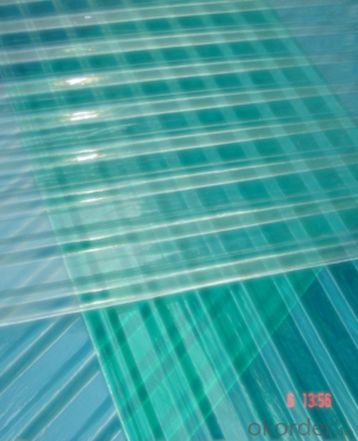
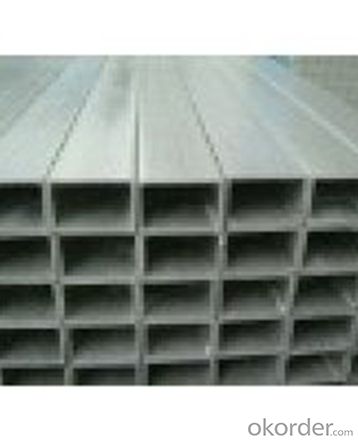
- Q:Can FRP pultrusion profiles be used in the renewable energy sector?
- FRP pultrusion profiles are definitely applicable in the renewable energy sector. They offer several advantages that make them suitable for various applications within the industry. One significant advantage of FRP pultrusion profiles is their exceptional strength-to-weight ratio. As large structures, like wind turbine blades or solar panel frames, are often involved in renewable energy projects, the lightweight nature of FRP profiles can significantly reduce transportation and installation costs. Additionally, their high strength ensures better load-bearing capabilities, guaranteeing the integrity and longevity of renewable energy infrastructure. Another benefit of FRP pultrusion profiles is their resistance to corrosion. Structures in the renewable energy sector are frequently exposed to harsh environments, such as offshore wind farms or coastal solar installations. The corrosion-resistant properties of FRP profiles make them an ideal choice as they do not rust or degrade when exposed to moisture, saltwater, or chemicals commonly found in these environments. This characteristic significantly reduces maintenance and replacement costs, making FRP profiles a cost-effective solution for the renewable energy sector. Moreover, FRP pultrusion profiles offer design flexibility. They can be custom-engineered to meet specific project requirements, allowing for the creation of complex shapes and sizes. This versatility enables the development of innovative and efficient renewable energy solutions, such as aerodynamically optimized wind turbine blades or lightweight support structures for solar panels. In conclusion, FRP pultrusion profiles are well-suited for the renewable energy sector due to their lightweight nature, high strength, resistance to corrosion, and design flexibility. These characteristics make them an excellent choice for various applications, including wind energy, solar power, hydroelectric projects, and more.
- Q:Can FRP pultrusion profiles be used in the construction of chemical storage tanks?
- Yes, FRP (Fiber Reinforced Polymer) pultrusion profiles can be used in the construction of chemical storage tanks. FRP materials are known for their excellent corrosion resistance properties, making them a suitable choice for storing a wide range of chemicals. Pultrusion profiles, which are made by pulling fiber reinforcements through a resin bath and then through a heated die, offer high strength-to-weight ratio, dimensional stability, and durability. FRP pultrusion profiles are non-reactive to most chemicals and are capable of withstanding harsh environments, including exposure to corrosive substances. They have low permeability, preventing chemicals from seeping through the tank walls. Additionally, FRP profiles can be customized to meet specific requirements, allowing for the construction of tanks with various shapes and sizes. Furthermore, FRP pultrusion profiles offer other advantages such as ease of installation, reduced maintenance, and long service life. They are lightweight, which simplifies transportation and installation processes. The low maintenance requirements of FRP tanks contribute to minimizing downtime and reducing overall costs. With proper design and construction, FRP pultrusion profiles can provide reliable and long-lasting solutions for chemical storage tank applications.
- Q:Can FRP pultrusion profiles be used in the construction of shipping containers?
- Indeed, the utilization of FRP pultrusion profiles in the construction of shipping containers is possible. These profiles offer numerous advantages that render them suitable for this purpose. To begin with, FRP pultrusion profiles possess exceptional strength and durability. They exhibit a high strength-to-weight ratio, enabling the creation of lightweight shipping containers capable of withstanding heavy loads and harsh environmental conditions. This characteristic proves particularly advantageous in the shipping industry, where containers endure rough handling and extreme weather while in transit. Furthermore, FRP pultrusion profiles display resistance to corrosion, a significant concern in the shipping industry due to exposure to saltwater and other corrosive substances. Unlike traditional materials like steel, FRP does not rust or corrode, thereby ensuring a longer lifespan for the shipping containers. Moreover, FRP pultrusion profiles exhibit excellent thermal insulation properties. This characteristic facilitates the maintenance of a consistent temperature within the shipping containers, which is crucial for transporting temperature-sensitive goods such as food, pharmaceuticals, and chemicals. Additionally, FRP pultrusion profiles can be easily customized and fabricated into various shapes and sizes, allowing for design flexibility in the construction of shipping containers. They can be molded to specific dimensions and incorporate features such as reinforcements, fastening points, and integrated insulation. Notably, FRP pultrusion profiles are also non-conductive and possess low thermal conductivity. These attributes make them an ideal choice for shipping containers that transport sensitive electronic equipment or hazardous materials, as they reduce the risk of electrical and thermal accidents. In conclusion, FRP pultrusion profiles can indeed be employed in the construction of shipping containers. Their strength, durability, corrosion resistance, thermal insulation properties, design flexibility, and non-conductive nature make them a reliable and practical choice for this application.
- Q:What are the limitations of FRP pultrusion profiles?
- There are several limitations associated with FRP (Fiber Reinforced Polymer) pultrusion profiles. 1. Limited Shapes and Sizes: Pultrusion technology is primarily suitable for producing linear profiles with constant cross-sections. It is challenging to create complex shapes or profiles with varying cross-sections using this manufacturing process. 2. High Initial Costs: The initial setup costs for pultrusion equipment can be quite high, making it less economically viable for smaller production runs. The machinery and molds required for pultrusion can be expensive and may require significant investment. 3. Limited Material Choices: While FRP pultrusion profiles offer excellent strength and corrosion resistance, the range of materials available for pultrusion is relatively limited. Typically, only a few types of reinforcing fibers, such as glass or carbon, are used. This limitation restricts the range of properties and applications of pultruded profiles. 4. Surface Finish: Pultruded profiles often have a rough surface finish, which may not be suitable for certain applications where a smooth or aesthetically pleasing appearance is desired. Additional steps, such as post-processing or coating, may be required to achieve the desired surface finish. 5. Tolerance Control: Maintaining tight dimensional tolerances can be challenging in pultrusion due to the inherent nature of the process. Variations in resin flow, fiber distribution, and curing can affect the final dimensions of the profile, which may require additional quality control measures. 6. Limited Design Flexibility: Unlike traditional manufacturing methods like extrusion or injection molding, pultrusion offers limited design flexibility. The constant cross-section of pultruded profiles restricts the ability to incorporate intricate features or varying thicknesses in the design. 7. Brittle Behavior: FRP pultrusion profiles tend to exhibit brittle behavior when subjected to high impact or sudden loads. While they possess high strength and stiffness, they may not have the same toughness as other materials like metals, making them prone to fracture under certain conditions. Despite these limitations, FRP pultrusion profiles offer numerous advantages such as high strength-to-weight ratio, corrosion resistance, and design versatility within their limitations. These profiles find applications in industries such as construction, aerospace, automotive, and marine, where their unique properties outweigh the drawbacks.
- Q:Are FRP pultrusion profiles UV-resistant?
- Yes, FRP pultrusion profiles are UV-resistant. The fiberglass reinforcement in the profiles provides excellent resistance to UV radiation, making them suitable for outdoor applications where exposure to sunlight is a concern.
- Q:Are FRP pultrusion profiles suitable for the manufacturing of chemical reactors?
- Yes, FRP pultrusion profiles are suitable for the manufacturing of chemical reactors. FRP (Fiber Reinforced Polymer) pultrusion profiles offer excellent resistance to corrosion, high strength-to-weight ratio, and dimensional stability, making them ideal for use in chemical reactors. Additionally, FRP materials can withstand a wide range of chemical environments and temperatures, making them a reliable choice for this application.
- Q:Is the test standard for FRP pultruded profiles and FRP gratings the same?
- Pultruded section is produced by extrusion automatic production line. Glass fiber reinforced plastic grille is produced by mould and hand laying process. If it is a pultrusion grille, it is also made of pultruded profiles, and it is different from the FRP molded grille.
- Q:Are FRP pultrusion profiles resistant to chemicals used in pulp and paper mills?
- FRP (Fiber Reinforced Polymer) pultrusion profiles are known for their excellent resistance to chemicals, making them a suitable choice for various applications, including those in pulp and paper mills. These profiles are specifically engineered to withstand exposure to a wide range of chemicals commonly used in these industries. The chemical resistance of FRP pultrusion profiles can be attributed to the inherent properties of the composite materials used in their construction. Typically, these profiles are composed of a combination of resins (such as polyester or vinyl ester) and reinforcements (such as fiberglass or carbon fiber). This combination imparts high chemical resistance to the finished product. The resins used in FRP pultrusion profiles play a crucial role in determining their chemical resistance. Polyester resins, for instance, provide good resistance to a variety of chemicals, including acids, alkalis, and solvents. Vinyl ester resins, on the other hand, offer even greater chemical resistance, making them suitable for highly corrosive environments. Additionally, the reinforcement materials used in FRP pultrusion profiles, such as fiberglass or carbon fiber, further enhance their chemical resistance. These reinforcements act as a barrier, preventing chemical penetration and protecting the structural integrity of the profile. It is important to note that the specific chemical resistance of FRP pultrusion profiles can vary depending on the resin and reinforcement materials used. Therefore, it is essential to select profiles that are specifically designed and manufactured to withstand the chemicals commonly found in pulp and paper mills. Overall, FRP pultrusion profiles are indeed resistant to the chemicals used in pulp and paper mills. Their high chemical resistance, combined with other advantageous properties such as high strength-to-weight ratio and corrosion resistance, make them an ideal choice for these demanding industrial environments.
- Q:Are FRP pultrusion profiles resistant to alkaline substances?
- Yes, FRP pultrusion profiles are generally resistant to alkaline substances. The composition and manufacturing process of FRP pultrusion profiles make them highly resistant to corrosion and damage caused by alkaline substances.
- Q:Are FRP pultrusion profiles impact resistant?
- Yes, FRP (Fiber Reinforced Polymer) pultrusion profiles are generally known for their high impact resistance. The combination of reinforcing fibers, such as glass or carbon, with a polymer matrix results in a material that is inherently strong and durable. The pultrusion process further enhances the impact resistance of these profiles by aligning the fibers in the direction of the load, providing optimal strength against impacts. FRP pultrusion profiles also have a high strength-to-weight ratio, which allows them to withstand heavy impacts without significant damage or deformation. This makes them suitable for applications where impact resistance is crucial, such as in construction, transportation, and infrastructure projects. Moreover, FRP pultrusion profiles offer excellent resistance against corrosion, chemicals, and UV radiation, which further contribute to their durability and long-term performance. These profiles can maintain their impact resistance properties even in harsh environments, making them a preferred choice for various industries. However, it is important to note that the specific impact resistance of FRP pultrusion profiles may vary depending on the specific design, composition, and manufacturing process. Therefore, it is recommended to consult with the manufacturer or supplier to ensure the profiles meet the desired impact resistance requirements for a particular application.
1. Manufacturer Overview |
|
|---|---|
| Location | |
| Year Established | |
| Annual Output Value | |
| Main Markets | |
| Company Certifications | |
2. Manufacturer Certificates |
|
|---|---|
| a) Certification Name | |
| Range | |
| Reference | |
| Validity Period | |
3. Manufacturer Capability |
|
|---|---|
| a)Trade Capacity | |
| Nearest Port | |
| Export Percentage | |
| No.of Employees in Trade Department | |
| Language Spoken: | |
| b)Factory Information | |
| Factory Size: | |
| No. of Production Lines | |
| Contract Manufacturing | |
| Product Price Range | |
Send your message to us
FRP pultruded grating with Anti-ageing and best quality on hot sales
- Loading Port:
- Tianjin
- Payment Terms:
- TT OR LC
- Min Order Qty:
- 4000 m.t.
- Supply Capability:
- 300000 m.t./month
OKorder Service Pledge
OKorder Financial Service
Similar products
New products
Hot products
Hot Searches
Related keywords

